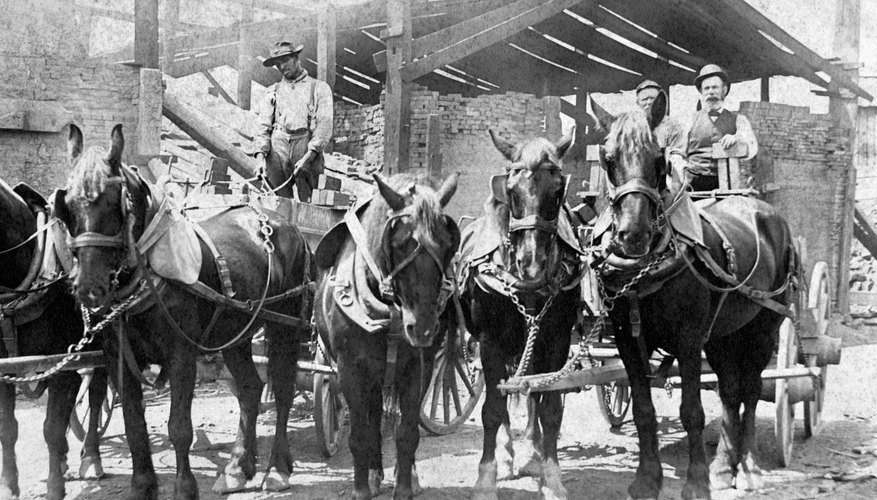Shafts for a horse-drawn cart or buggy flank the horse and connect the vehicle to the horse and harness, representing the steering mechanism. "The horse has to learn to push the shafts left or right, to turn," says Dave Engel, proprietor of Engel's Coach Shop, but pulls the vehicle's weight from the swingletree mounted to the shaft crossbar behind the horse. For horse carts (two-wheeled vehicles), proper distribution of the load -- the driver and goods or passengers -- steadies and balances the cart. The shafts, designed for single-horse driving, also help hold the cart level.
- Shafts for a horse-drawn cart or buggy flank the horse and connect the vehicle to the horse and harness, representing the steering mechanism. "
- For horse carts (two-wheeled vehicles), proper distribution of the load -- the driver and goods or passengers -- steadies and balances the cart.
Measure shaft length from the shaft tips to the front of the cross bar -- the bar that connects and stabilises the two shafts near the cart -- for most buggies and other four-wheel horse-drawn vehicles. Accurate measurement is important to make sure buggy shafts fit the horse: typically 221 cm (87 inches) in length for draft horses, 190 or 193 cm (75 or 76 inches) for most saddle horses, 152 to 165 or 167.5 cm (60 to 65 or 66 inches) for small to large ponies and 122 or 137 cm (48 or 54 inches) for miniature horses. Shafts need to be the right size to attach correctly to the horse or pony harness.
Add 30 cm (12 inches) to these lengths (above) for comparable horse cart shafts, typically offered in pony, saddle horse and draft horses sizes. The two main differences between buggy shafts and cart shafts are shaft length and the method that cross bars attach. To make room for the driver's footboard, cart shafts are about a foot longer, and the shaft crossbar for carts is mounted either above or below the two shafts, rather than mortised between them as with buggy shafts.
- Add 30 cm (12 inches) to these lengths (above) for comparable horse cart shafts, typically offered in pony, saddle horse and draft horses sizes.
- To make room for the driver's footboard, cart shafts are about a foot longer, and the shaft crossbar for carts is mounted either above or below the two shafts, rather than mortised between them as with buggy shafts.
Add a circle brace to your two cart shafts, attached just ahead of the crossbar, for extra stability and safety -- essential for cart shafts but optional for shafts used with buggies.
Consider, too, the various shaft styles. Both buggy and cart shafts come in drop heel and double bend styles, the latter used to position both crossbar and swingletree well ahead of the point of shaft attachment to the axle -- needed to avoid problems during sharp turns for vehicles with "forward" bodies. Cart shafts also come in a straight heel style for use with village and Meadowbrook carts.
TIP
Top quality shafts are made from hickory wood because of its superior strength. Rather than replace a shaft that has a broken tip, you can repair it by sawing off the broken section, then sliding a metal shaft repair horn into place. Most donkeys would need large pony sized cart shafts, but mules would need horse sized shafts.
